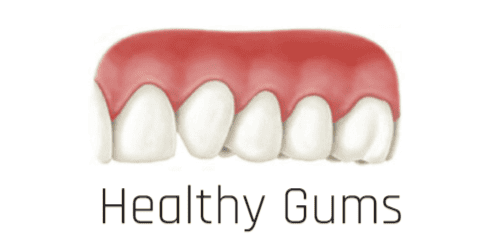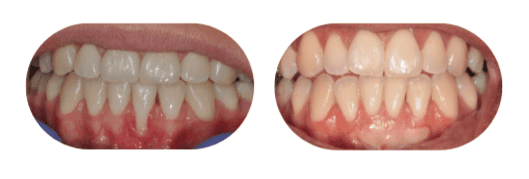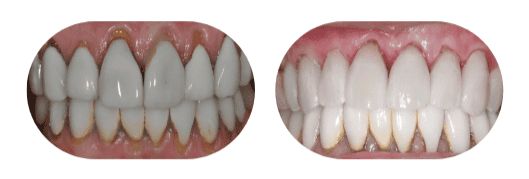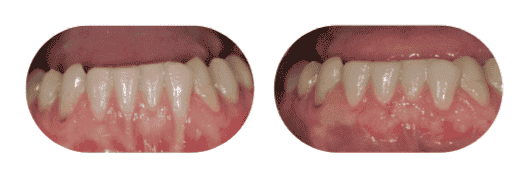
Receding gums, also called gingival recession, is the movement of the gums exposing the roots of the teeth. In a healthy situation, the root of the tooth should be covered up completely by the jaw bone and the gums. If the roots can be seen, this is an indication that there has been a loss of the foundation around the tooth. Receding gums can lead to hot and cold tooth sensitivity, longer-looking teeth, an unpleasant smile, and even infection or loss of teeth. It is important to identify and treat the process of recession early to prevent these issues
The diagram illustrates a clear demarcation between healthy gums and gums experiencing recession. In the healthy gum section, the tissue appears pink, firm, and tightly surrounds the teeth, providing optimal support and protection. Conversely, in the recession area, the gums display signs of shrinkage, appearing visibly thinner and receded from the tooth surface. This recession exposes the tooth roots, potentially leading to sensitivity, increased risk of decay, and compromised dental health.


The diagram illustrates a clear demarcation between healthy gums and gums experiencing recession. In the healthy gum section, the tissue appears pink, firm, and tightly surrounds the teeth, providing optimal support and protection. Conversely, in the recession area, the gums display signs of shrinkage, appearing visibly thinner and receded from the tooth surface. This recession exposes the tooth roots, potentially leading to sensitivity, increased risk of decay, and compromised dental health.

Gum recession signals potential underlying issues, requiring treatment to address health, sensitivity, and aesthetics. Treatments vary based on recession severity and individual concerns.
Initally, you want to address gum recession by scheduling an exam or consultation to assess the health of your gums and discuss treatment goals. The primary objectives of treating recession are to strengthen the gum tissue surrounding the teeth and, if possible, enhance the appearance by
covering exposed roots.
The most reliable and natural treatment for gum
recession is gum grafting. Gum grafting is a
surgical procedure that involves taking tissue from
one area of the mouth and grafting it onto the gum
tissue to cover exposed tooth roots.
At Transcend Dental Implants and Periodontics, we
are dedicated to helping patients achieve a
healthier mouth and a more beautiful smile
through comfortable and innovative techniques.
When it comes to gum recession, dental plaque stands as a primary culprit, gradually eroding gum tissue due to bacterial buildup. Meanwhile, trauma to the gums, whether from aggressive brushing, teeth grinding, or injury, can also contribute significantly to the recession, causing damage and weakening the gum’s supportive structures.
Sticky film made of bacteria and food particles that builds up around the teeth daily is known as dental plaque. If this is not removed regularly with thorough brushing, flossing, and routine dental visits, it can lead to gum disease. Gum disease is the loss of the foundation around the teeth and is one of the leading causes of tooth loss in the world.
The second most common cause of recession is caused from trauma to the gums. There are many sources of trauma, including overly aggressive brushing and flossing, injuries from eating hard foods, excessive biting forces, grinding and clenching of the teeth, braces, or movement of the teeth.
To prevent tooth structure damage, use gentle tools like a soft-bristled toothbrush and non-abrasive toothpaste, especially if prone to recession. Address biting issues with a bite adjustment or night guard. Tension-causing factors like frenums can also contribute and may need attention. Treatment should be tailored to each patient’s specific causes to halt further recession.

A gingival graft is a surgical procedure where gum tissue is taken from one area of the mouth and transplanted to another to restore or enhance gum tissue around teeth. It’s often used to treat gum recession, improve aesthetics, and protect tooth roots from exposure.

The Chao Pinhole Technique is a minimally invasive gum recession treatment where a small hole is made in the gum tissue, allowing the dentist to gently reposition the tissue over the exposed roots using special instruments, without the need for traditional gum grafting surgery.

A root coverage graft is a surgical procedure aimed at covering exposed tooth roots caused by gum recession. Tissue is typically taken from another part of the mouth or a donor source and grafted onto the recession site to restore gum tissue and protect the underlying tooth structure.



